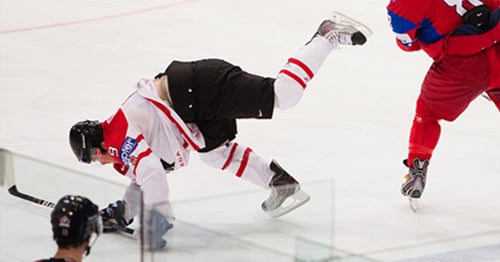Hockey Injuries and Conditions
Athletes from more than 50% of all professional major league sports teams, including the National Hockey League (NHL), come to HSS for orthopedic care when they are faced with an injury. Our dedication to advancing the field of sports medicine through research, innovation and collaboration are unparalleled in the professional sports arena.

HSS takes pride in bringing that level of dedication to all of our patients, from the recreational weekend warrior to junior varsity and college level players.
Top 5 most common hockey injuries
As a collision sport, hockey is a high risk sport for injuries across the entire body. Prevention should be a top priority and includes wearing protective gear, performing strength training exercises, and using proper technique while playing. The most common injuries while playing hockey are:
- Concussion: the most common injury sustained by players after making contact with the boards, the ice or other players. Wearing well-fitting headgear is integral to prevention. If the player is dizzy, loses consciousness or has a headache after a head injury, it is important to have them checked by a physician and cleared for play.
- Separated shoulder: occurs due to impact on the ice. Players should wear properly fitted shoulder pads and try to fall on the outside of the arm. A minor injury to the soft tissue or a shoulder dislocation may require a few days or weeks of rest, but if a ligament or other structures in the shoulder are badly damaged, then surgery is usually required.
- MCL knee injury: on the inner part of the knee, the MCL (medial collateral ligament) can be sprained or torn by a hit from the outside of the knee. These are more common than ACL injuries due to the nature of the game and the impact. Having a good strength training regimen, avoiding overuse and perfecting technique will help prevent injury.
- Groin pain and/or a pulled hamstring: imbalances in the hip most often leads to groin injuries. Exercises that balance the abductors (outside of hip) and the adductors (inside near groin), along with resistance and balance training can prevent injury.
- Ankle sprain and injury: a pair of well-fitting skates can prevent sore feet and potential ankle injuries, but an impact or fall on ice may have too much force. Ankle fractures can occur and require immediate attention from a highly qualified surgeon. Sprains should not be ignored and treated using the RICE method (rest, ice, compression and elevation).
